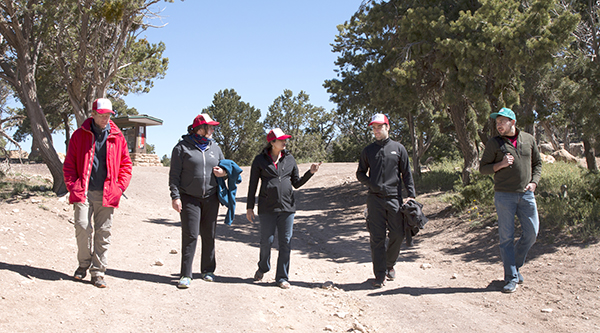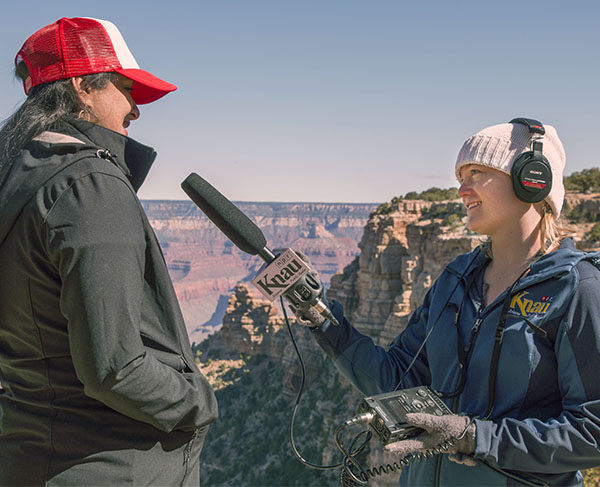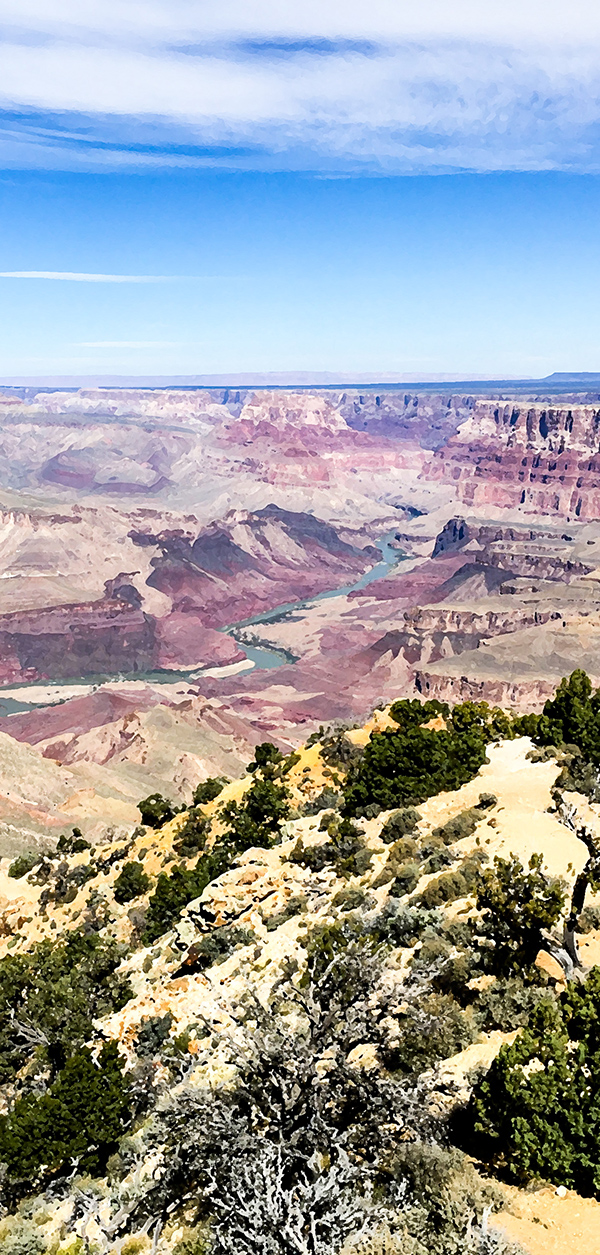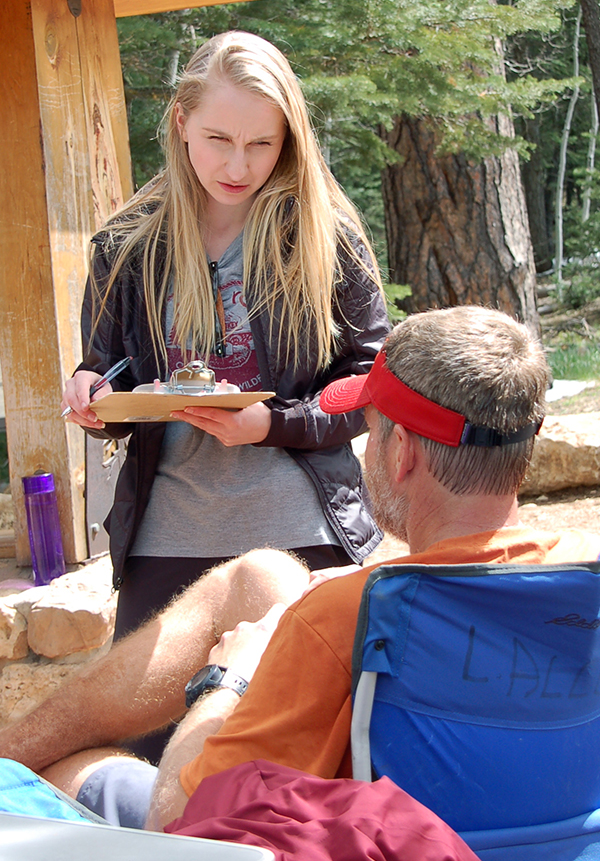Sandia team continues to quantify fatigue using wearables
This is the second story in a series about the R2R WATCH (Rim-to-Rim Wearables at the Canyon for Health) study, a collaborative project between Sandia and the University of New Mexico (UNM). The interdisciplinary project, led by Glory Emmanuel Aviña from Sandia and Jon Femling from UNM, weaves cognitive science, emergency medicine, systems biology, data science, and sensor technology together to examine early predictors of health events. Lab News reporters Patti Koning and Michael Padilla returned to the Grand Canyon, this time to focus on the results of the R2R WATCH team’s partnerships and to see how the team is quantifying performance and fatigue.

It’s 27 degrees at the South Kaibab trailhead, and a set of hikers marvels at the fresh snow visible on the opposite side of the Grand Canyon as the sun peeks just above the horizon. By the time the hikers reach the bottom of the canyon four to six hours later, the snow will be long melted, and the temperature will be at least 30 degrees hotter.
The hikers are ready for the physical trial that lies ahead: 21 miles from rim to rim, including a one-mile change in elevation, extreme swings in temperature, and the mental challenge of the uphill second half. But for the hikers who have volunteered to be in the R2R WATCH study, the first step is to check in at the R2R WATCH tent near the entrance of the south trail. The Sandia and UNM teams collect vital health information from the volunteer hikers, administer cognitive tests, and outfit them with wearable fitness devices. These devices will provide a window into the hikers’ physiological changes during their rim-to-rim trek.
“What indicators predict the early onset of declines in performance or health?”
This is the second R2R WATCH data-collection study at the Grand Canyon, part of a three-year effort funded by the Defense Threat Reduction Agency (DTRA). The Sandia team is once again collaborating with UNM and the National Park Service (NPS), forming a unified R2R WATCH team that is merging multiple data streams to answer a single question: “What indicators predict the early onset of declines in performance or health?”
Project team members have been at the South Rim since 2 a.m., preparing to greet the first set of hikers, a military group that arrives at 3 a.m. Each study participant is fitted with a wearable device, receives a smartphone for cognitive assessments, has a few teaspoons of blood drawn, and completes a pre-trek survey.

“This study allows us to correlate physiological and cognitive markers to rim-to-rim hike performance,” says Cathy Branda, the Sandia project manager. “We can also compare military study participants to civilian volunteer hikers, a comparison of great interest to DTRA.”
According to Glory Emmanuel Aviña, Sandia’s principal investigator for R2R WATCH, identifying which physiological and cognitive markers are most important for predicting performance and fatigue poses a scientific challenge. To then wrap those markers with their different sensor-technology requirements into a single wearable device will be a future engineering feat.
“One of our long-term objectives is real-time data analytics,” Glory says. “Right now we collect data, download data after the hike, and then analyze it. But what if you could analyze the data in real time and identify health concerns before someone had a severe decline in performance? Those predictors could be physiological, like heart rate variability, but they could also be cognitive or genetic.”
Strong partnership
Sandia’s R2R WATCH study began in 2016 in response to a DTRA call for proposals to evaluate commercial and government off-the-shelf wearable devices. R2R WATCH is an extension of a previous UNM/NPS study —launched in 2015 by Emily Pearce, a former Grand Canyon park ranger — that focused on the nutritional intake of rim-to-rim hikers.
“Everyone brings a unique contribution to the table,” says Glory. “UNM has years of experience in emergency response, clinical populations, bloodwork, and nutritional data, enabling us to create a one-of-kind, world-class dataset that capitalizes on the UNM infrastructure for collecting physiological data. We are also thankful that the National Park Service allowed our study to take place in the Grand Canyon, which offers both a controlled environment and an ideal setting for studying performance and fatigue since the hikers have to come back up after descending into the canyon depths.”
“The R2R WATCH study is a balancing act between pursuing science and being considerate of the study participants.”
Sandia provides expertise in collecting data from the wearable devices, as well as fusing the multiple data streams such as wearable devices, cognitive tests, biometrics, and blood samples and teasing out meaningful trends. Sandia’s advanced capabilities in computational analysis are crucial to solving this part of the problem.
Dr. Jon Femling from UNM says the strength of this partnership goes beyond the considerable expertise of the team.
“Our collaborative study design will allow us to improve Grand Canyon visitor experiences, enhance military capabilities, expand our knowledge of exercise physiology and improve the care of patients,” says Femling.

The data generated by military personnel in the study is analyzed to understand performance decline in national security settings.
Ed Argenta, Science & Technology manager for DTRA’s Chemical and Biological Technologies Department, says the project will enable DTRA to use real-time data collection and quantitatively show how markers relate to a non-laboratory, mission-relatable performance task. Findings on individual markers also will inform which wearable devices are most useful both in the attributes they measure and the logistics of use.
“The partnership between Sandia and UNM has benefited DTRA tremendously,” he says. “The Sandia team has provided strong connections with military communities of interest and has recruited individuals to participate in the data collection events. The data collected is critical for analysis and algorithm development, which Sandia is managing and performing as well.”
Argenta says UNM has provided subject matter expertise on the medical perspective and brought innovative ideas to the project, benefitting the project’s data package and subsequent analysis.
“Overall the entire team has been great to work with and our department looks forward to continuing the partnership with Sandia and UNM under this effort,” Argenta says. “The goal of developing an early warning to a biological or chemical exposure capability for our warfighters is important. Without great partners it will not come to fruition.”
Reaching the North Rim
At the North Kaibab Trail on the North Rim of the Grand Canyon, a pair of hikers appear wearing the red wristbands that identify them as participants in the R2R WATCH study. Victoria Newton, a core member of the study team, congratulates them on finishing the arduous journey.
The hikers flop into camp chairs in front of the R2R WATCH tent and gladly accept some soft drinks. After giving the hikers a few minutes to rest, the researchers spring into action, removing and cataloging the wearable devices. A UNM student administers a survey of questions about their hike. When asked if they’d choose the same hiking companions again, the two hikers laugh and answer affirmatively. They then take the last round of cognitive tests.

Next, the hikers are handed off to other team members who repeat the early-morning data collection tasks first performed at the South Rim. The researchers weigh the hikers and their backpacks, record their pulse and blood oxygen levels, measure their BMI and body fat with a bioelectrical impedance analysis device, and collect blood samples. This data will be used to quantify the hikers’ performance and fatigue, as well as associated indicators.
“The hikers willing to do R2R or R2R2R are incredibly inspiring.”
“We were able to collect a lot of useful data, especially because a lot of the volunteer hikers agreed to wear devices, do cognitive tests, and have blood drawn,” says Victoria. “The hikers willing to do R2R or R2R2R are incredibly inspiring. It was fun to see the hikers cheering each other on as they reached the top of the Rim and then to how seriously the same hikers took the cognitive tasks. Some got pretty competitive.”
Quantifying fatigue
Fatigue is defined as extreme tiredness, typically resulting from overexertion — either physical or mental — or illness. We easily recognize our own fatigue when it hits, but the cause and seriousness are often unclear. If you wake up feeling fatigued, does that signal an impending illness, a poor night’s sleep, or excessive stress? Will you shake off that fatigue as the day progresses, or will it continue to wear you down?
“We sometimes sense that we are about to get sick or that external stress is beginning to affect our health,” says Glory. “With this study, we hope to identify predictive signatures for fatigue and quantify the type of fatigue. Is it manageable, meaning your body can recover if you remove the cause, or indicative of a potentially catastrophic health outcome?”
The range in outcomes is clear in the study volunteers after completing the hike. Some are so exhausted they can’t speak when they first approach the R2R WATCH team. Another pair debates hiking back to the South Rim — 21 more miles! They decide to take a shuttle only after realizing that the return hike would stretch into the early hours of the morning—they were worried about being cold, not tired.
Understanding fatigue could have broad impact. “For the military or other physically demanding professions, being able to discern the level and effect of fatigue could be life-changing. For example, when someone is fatigued, can that person keep going or is the fatigue at a level that endangers the individual, mission, or both?” says Cliff Anderson-Bergman, lead project statistician.
Results
Preliminary results have shown a decline in cognitive scores as fatigue sets in. Functional clustering methods also suggest differing effort profiles across subjects, which likely affected fatigue in different ways. Further planned analyses include examining how accurately heart rate variability captures the onset of fatigue and matching different effort profiles to the effects on the metabolic panel data collected before and after the hike.
Up next
The team will continue to analyze the data and plans on collecting more R2R WATCH data in October.
“Like other human-subjects studies, the R2R WATCH study is a balancing act between pursuing science and being considerate of the study participants,” says Glory. “Thousands of hours are spent preparing for data collection. We can’t just throw devices on a person and stick them with a needle. You have to balance caring about a person’s rim-to-rim hiking experience with collecting solid, unbiased data that answers key research questions. That’s a balance that we continue to work toward.”